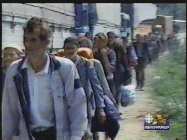

The Women of Srebrenica
A recent BBC article on the organization
founded to seek the truth about the massacre.
founded to seek the truth about the massacre.

Footage and sound recordings of the Auschwitz-style separation of men from women at Srebrenica were taken by a Serb photographer. I scanned a number of still images from the brief footage broadcast by CBC Newsworld in a profile of Slobodan Milosevic. Two galleries of photographs follow an excerpt from "Pity the Innocent Men," my article for The Globe and Mail (20 February 1999), describing the atrocity (or link now to Photo Gallery I).
In September, 1996, after 14 months rotting in the woods and fields, the victims of the Srebrenica massacre are finally removed. Among the skeletons is "evidence of a people hoping to survive," Associated Press reports: "loose pieces of clothing soiled by a year of rains and snows, ID cards ... a pair of broken eyeglasses."
The 7,079 dead were victims of Europe's greatest atrocity since the Second World War. They shared two characteristics. They were Muslim. And they were male.
The previous year, 450 Dutch UN troops had stood by as Serb forces under Ratko Mladic occupied the Srebrenica "safe area." Thousands of men were rounded up. Thousands of women and children, along with several hundred men, made it to the UN base at Potocari. Dutch troops watched as Serb soldiers entered the compound and selected women for sexual assault, men for torture and execution. Elsewhere in the safe area, the mass killings of male detainees were already beginning. At least some of the Dutch knew this.
The Dutch troops negotiated with the Serbs to evacuate the women and children to safety. In return, the peacekeepers compiled lists of all males aged 17 to 65 in the UN compound. The Dutch expelled the 239 remaining Muslim men into the arms of waiting Serb soldiers. Then they left, not even bothering to sound the alarm about the mass executions. All told, David Rohde writes in Endgame (citing Red Cross sources), "nearly 3,000 men were summarily executed" at Srebrenica, and "over 4,000 hunted down like animals."
The following month, the UN again fled the field. The women, children, and very old men of another "safe area" -- Zepa -- were evacuated, leaving about 3,000 "battle-age" men trapped. This time fortune was kinder. Ably led, almost all survived a hazardous trek to Muslim-controlled territory.
Srebrenica's dead returned to the headlines in early 1996, when women from the city stormed Red Cross offices in Tuzla to protest the stalled investigations into the fate of their missing relatives. "My husband was taken away, my brother too, like all the men," said a young Muslim woman. The women's anguish was plain, and the passage of time had added practical concerns as well: "The younger women have no hope of finding another husband until the death of the first husband has been proved," said a Red Cross official.
Why would UN peacekeepers stand idly by as hapless male victims were carted off to the slaughterhouse? Why would they then expel the remainder to face certain death? Somehow, the Dutch peacekeepers could not "see" the vulnerability of Srebrenica's men. "It was not easy, watching wives and kids taken away from their men," said one Dutch corporal after the massacre. It neatly summarized the prevailing mindset.
In numerous conflicts, men have been exposed to conscription, detention, torture and summary execution. Women and children, despite vulnerabilities of their own, are more likely to receive safe passage through battle lines, as well as effective protection from the UN and other international agencies. Even the men of threatened communities like Srebrenica tend to contribute to the bias, by respecting the ancient edict of "women and children first" ...


Back to the Gender Page of the site.
Back to the Index Page of the site.